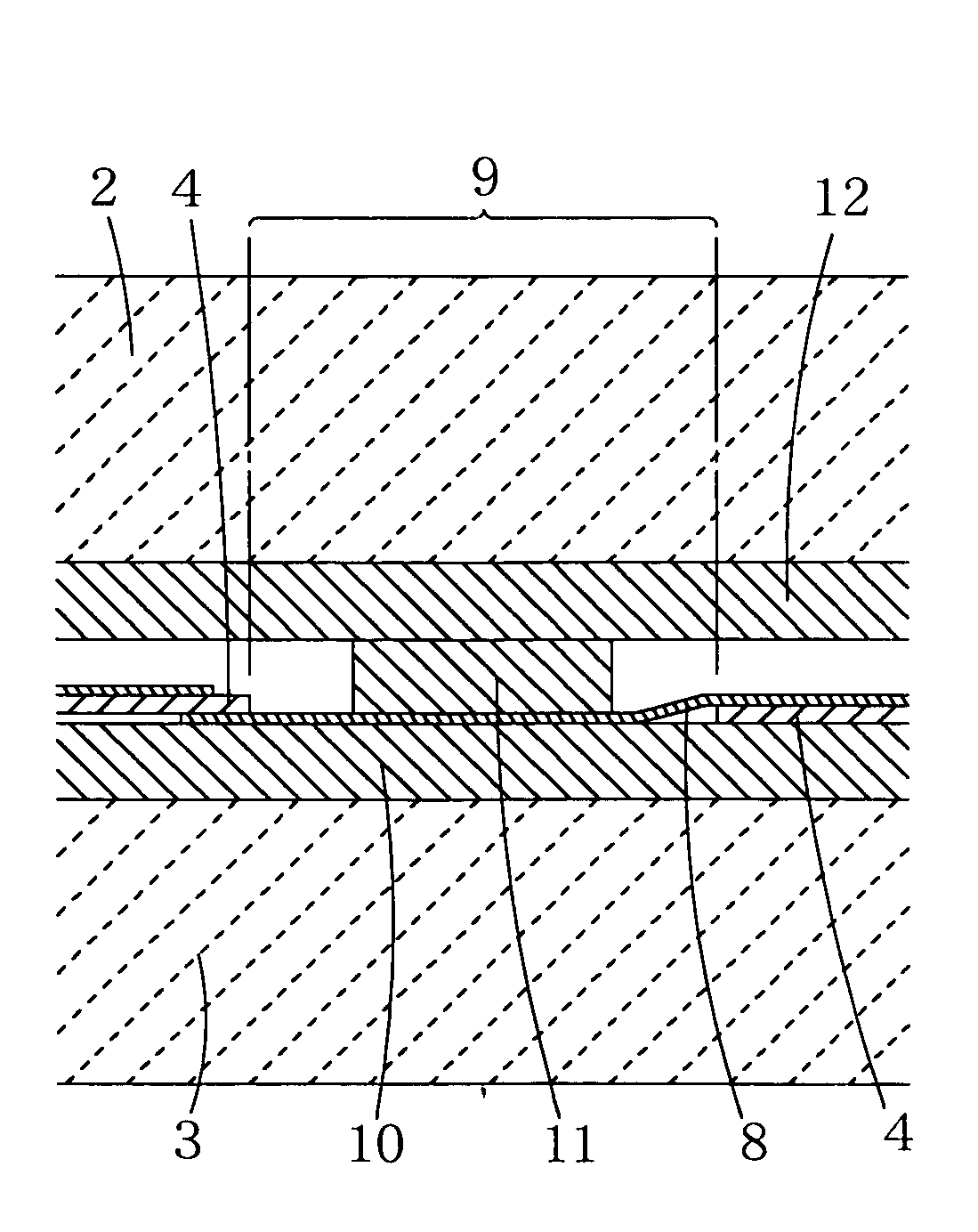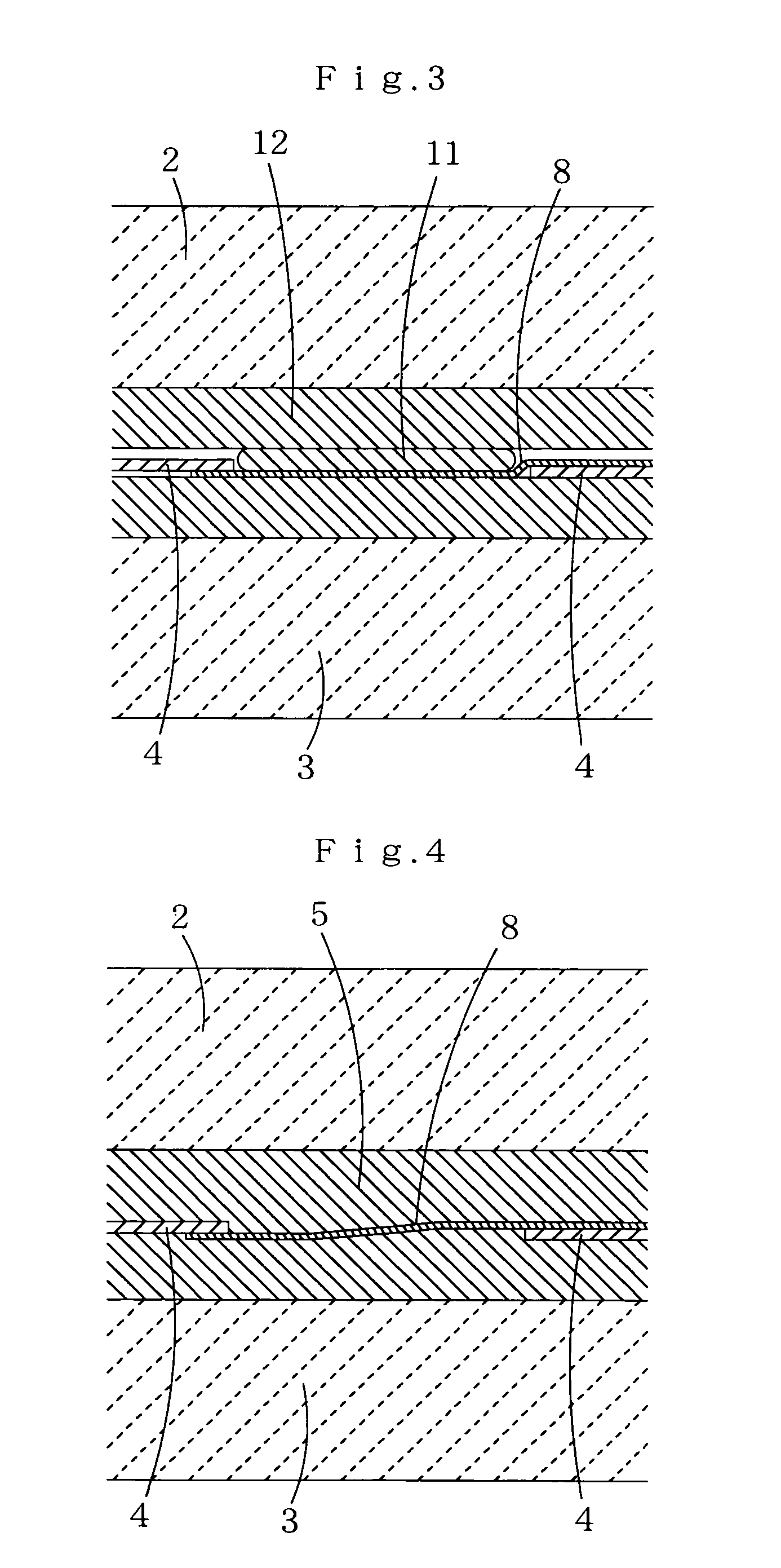Solar battery module manufacturing method
a solar battery and manufacturing method technology, applied in the direction of light radiation electric generators, generators/motors, pv power plants, etc., can solve the problems of unavoidable breakage of a part of cells receiving an excessive load, difficult to avoid breakage of solar battery cells, and large load likely to be uniformly applied, so as to achieve the effect of inhibiting flow
- Summary
- Abstract
- Description
- Claims
- Application Information
AI Technical Summary
Benefits of technology
Problems solved by technology
Method used
Image
Examples
example 1
[0080]Forty of square polycrystalline silicon solar battery cells of 125 mm×125 mm×0.35 mm were used as the solar battery cell 4. Four corners are chamfered by approximately several millimeters. A solder dip copper ribbon wire manufactured by Marusho K.K. was used as the conductor 8. The ribbon wire has a width of 1.5 mm and a thickness of 0.25 mm. Solder is previously printed in a portion where the conductor 8 is bound in light reception surface 6 and the back face 7 of the solar battery cell 4. One end of the conductor 8 was superimposed on a solder printing portion of the light reception surface 6 of the solar battery cell 4 and soldered, and the other end was superimposed on a solder printing portion of the back face 7 of the adjacent solar battery cell 4 and soldered. The cells adjacent to each other were connected to each other by two conductors 8, and a distance thereof was set at 50 mm. That is, the width of the space 9 is 50 mm.
[0081]As the back face panel 3, a float plate ...
example 2
[0106]Solar battery modules were obtained in the same manner as in Example 1 by employing the sheet piece arranging pattern A and the sheet piece arranging pattern B, except that the temperature and the pressure at the time of the sealing treatment were changed as shown in Table 2 and FIG. 12.
[0107]
TABLE 2Treatment timeIntegrated timeTemperaturePressure(min)(min)(° C.)(MPa)Step 11127 → 50 0.1 →Step 230317010150 → 7130131711414571 → 74Step 33317874 → 814322181 → 900.075226903025690 → 30125730Step 43028730 → 15535322155Step 530352155 → 30135330 0.07 → 0.1
[0108]In all of the case of employing the sheet piece arranging pattern A and the case of employing the sheet piece arranging material B, the resulting solar battery modules were quite free from occurrence of cell cracks or defects and breakage of the conductor and were not observed with respect to remaining of air bubbles and the flowing out of the sealing resin or sinks in the surroundings. Also, the spaces between the solar battery...
example 3
[0111]Solar battery modules were obtained in the same manner as in Example 1 by employing the sheet piece arranging pattern A and the sheet piece arranging pattern B, except that the temperature and the pressure at the time of the sealing treatment were changed as shown in Table 3 and FIG. 13.
[0112]
TABLE 3Treatment timeIntegrated timeTemperaturePressure(min)(min)(° C.)(MPa)Step 11120 → 500.1 →Step 23031457650 → 7130106711412071 → 74Step 33315374 → 814319681 → 900.073022690Step 43025690 → 15535291155Step 530321155 → 301322300.07 → 0.1
[0113]In all of the case of employing the sheet piece arranging pattern A and the case of employing the sheet piece arranging materials b, the resulting solar battery modules were quite free from occurrence of cell cracks or defects and breakage of the conductor and were not observed with respect to remaining of air bubbles and the flowing out of the sealing resin or sinks in the surroundings. However, a part of the spaces between the solar battery cells...
PUM
 Login to View More
Login to View More Abstract
Description
Claims
Application Information
 Login to View More
Login to View More - R&D
- Intellectual Property
- Life Sciences
- Materials
- Tech Scout
- Unparalleled Data Quality
- Higher Quality Content
- 60% Fewer Hallucinations
Browse by: Latest US Patents, China's latest patents, Technical Efficacy Thesaurus, Application Domain, Technology Topic, Popular Technical Reports.
© 2025 PatSnap. All rights reserved.Legal|Privacy policy|Modern Slavery Act Transparency Statement|Sitemap|About US| Contact US: help@patsnap.com



